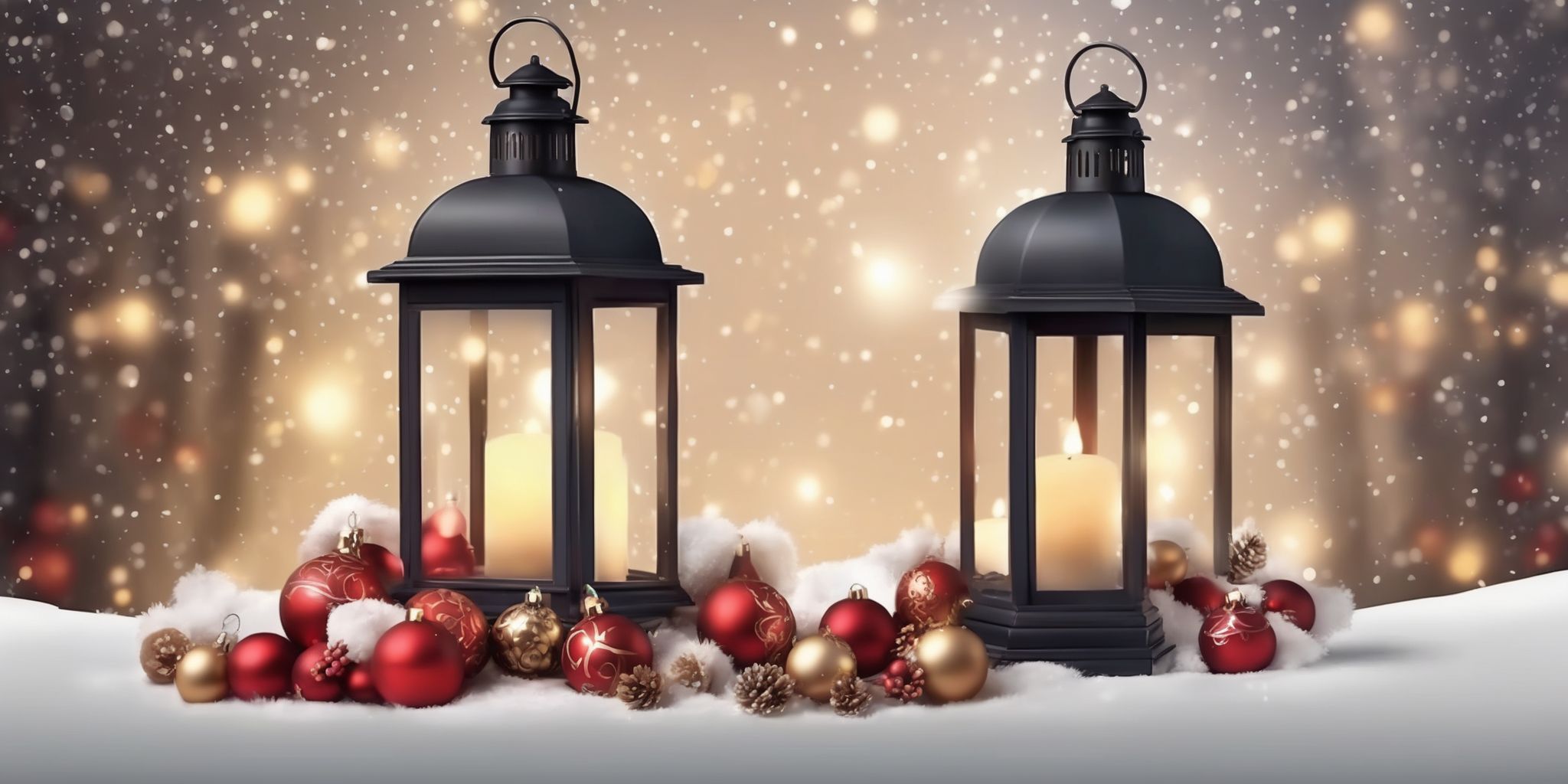- Blog
- Christmas lights
- How to Hang Christmas Lights: A Step-by-Step Guide for a Stunning Display

Ah, the twinkling glow of Christmas lights—nothing says holiday spirit quite like a beautifully lit display adorning our homes and creating a magical ambiance in the cold winter nights. But hanging those lights can be a daunting task, leaving us tangled up in a web of confusion. Fear not, fellow festive enthusiast! In this step-by-step guide, we'll unravel the mysteries of Christmas light installation, turning your house into an enchanting spectacle that would make Santa himself stop and admire.
So grab your toolbox, put on your favorite holiday tunes, and let's light up the neighborhood with a stunning display of Yuletide cheer!
Why Hanging Christmas Lights Can Transform Your Home
- Create a Festive Atmosphere: Christmas lights instantly add a magical touch to your home, creating a warm and joyful ambiance that captures the spirit of the holiday season.
- Boost Curb Appeal: By hanging Christmas lights, you can make your home stand out in the neighborhood, attracting attention and admiration from passersby.
- Highlight Architectural Features: The strategic placement of lights can accentuate the unique architectural elements of your house, such as windows, columns, or rooflines.
- Show Off Your Style: Whether you prefer a classic white display or a vibrant, colorful spectacle, hanging Christmas lights allows you to showcase your personal taste and creativity.
- Spread Holiday Cheer: By illuminating your home with Christmas lights, you can bring joy and a sense of celebration to your community, spreading the holiday spirit far and wide.
Important Safety Precautions to Consider
When hanging Christmas lights, it is important to prioritize safety to prevent accidents and electrical hazards. Begin by inspecting all lights and cords for any signs of damage or fraying. Make sure to use outdoor-rated lights specifically designed for outdoor use. Use proper extension cords that are rated for the wattage of your lights and avoid overloading them. It is crucial to follow the manufacturer's instructions for hanging lights and avoid installing them near flammable materials.
Additionally, use a sturdy ladder and have a spotter when working at heights. By taking these safety precautions, you can enjoy a beautiful and safe holiday display.
Step 1: Planning Your Christmas Light Display
Assessing Your Lighting Needs
Before you start hanging your Christmas lights, it's important to assess your lighting needs. Consider the size and layout of your home or yard to determine how many strands of lights you'll require. Look at the architectural features you want to highlight and think about the overall effect you're aiming for. For example, if you want a subtle display, a few strands may suffice. However, if you want a more dramatic look, you may need additional lights. By carefully evaluating your lighting needs, you can ensure you have enough lights to create the desired impact without overwhelming your space.
Choosing the Right Type of Christmas Lights
When choosing the right type of Christmas lights to hang, consider both the aesthetic and practical aspects. LED lights are energy-efficient and long-lasting, making them a popular choice. They come in various colors, shapes, and sizes to suit different preferences. Incandescent lights offer a warm, traditional glow but use more energy and have a shorter lifespan. Consider the size of your display area when deciding on the bulb count and length of the lights.
Estimating the Amount of Lights Needed
- Measure the perimeter of the areas where you plan to hang lights (e.g., roofline, windows, doors).
- Consider the spacing between each light bulb to determine density.
- Use a general rule of thumb of 100 lights per 1-1.5 feet of space.
- Remember to account for additional decorations or areas you want to highlight.
- Take into account the length of each string of lights available for purchase.
- Opt for LED lights if energy efficiency and longevity are a priority.
- Consider purchasing extra lights to have backups in case of bulb failures or future expansions of your display.
Step 2: Gathering the Necessary Tools and Supplies
List of Tools and Supplies You'll Need
When it comes to hanging Christmas lights, having the right tools and supplies is important to ensure a smooth and successful installation. Here are some items you'll need:
- Ladder or scaffolding: Depending on the height of your home, a sturdy ladder or scaffolding will help you reach the desired areas safely.
- Outdoor extension cords: Choose heavy-duty cords that are specifically designed for outdoor use to provide power to your lights without any safety concerns.
- Clips or hooks: These handy accessories allow you to securely attach your Christmas lights to various surfaces, such as gutters, shingles, or fences.
- Timers or controllers: These devices offer convenience by automatically turning your lights on and off at designated times, helping you save energy and avoid unnecessary hassles.
- Light tester: To troubleshoot any issues and ensure all lights are functioning properly, use a light tester to quickly identify and replace any faulty bulbs.
Remember to consider the size of your project and the specific requirements of your display when gathering tools and supplies.
Step 3: Preparing Your Home for Christmas Lights
Inspecting Your Outlets and Extension Cords
- Before hanging your Christmas lights, it's important to inspect your outlets and extension cords to ensure they are safe and in good working condition.
- Check for any visible damage such as frayed wires, exposed copper, or cracked plugs on your extension cords. If you spot any issues, replace them with new ones to prevent electrical hazards.
- Test your outlets using a voltage tester to ensure they are providing the correct voltage. Faulty outlets can cause power surges or short circuits, so it's crucial to address any problems before connecting your lights.
- Consider using outdoor-rated extension cords that are specifically designed for outdoor use. These cords are built to withstand different weather conditions and are less likely to be damaged by moisture or UV exposure.
Remember, prioritizing safety when inspecting your outlets and extension cords will help ensure a worry-free and joyful Christmas light display.
Cleaning and Testing Your Christmas Lights
Cleaning and testing your Christmas lights is an important step before hanging them. Dust, dirt, and debris can accumulate on the lights during storage, affecting their brightness. To clean them, gently wipe each bulb with a damp cloth or use a mild cleaning solution. After cleaning, it's crucial to test each light strand to identify any faulty bulbs or wiring issues. Plug the lights into a power source and check for any flickering or non-working bulbs.
Replace any faulty bulbs or consider purchasing LED lights, which are more durable and energy-efficient. Proper cleaning and testing ensure a vibrant and fully functional light display for the holiday season.
Checking the Safety of Your Roof and Gutters
Before hanging your Christmas lights, it's important to assess the safety of your roof and gutters. Inspect the condition of your roof to ensure it can support the weight of the lights without causing any damage. Look out for loose or missing shingles, as they can pose a hazard.
Additionally, check your gutters for any debris or blockages that could prevent proper water flow. Clogged gutters can lead to water damage and ice dams during the winter months. Clear them out to avoid potential problems.
Regularly monitoring the condition of your roof and gutters helps prevent accidents and ensures a secure foundation for hanging your Christmas lights.
Step 4: Mapping Out Your Christmas Light Design
Creating a Design Plan
Creating a Design Plan for your Christmas lights display is essential to achieve a visually stunning and harmonious look. Here's how you can do it:
- Evaluate the architecture and features of your home to identify the best locations for lights.
- Consider the overall theme or aesthetic you want to achieve. Do you prefer a classic look, a colorful display, or a modern twist?
- Strategize where to hang lights, such as rooflines, windows, trees, or pathways, to highlight your home's unique features.
- Use different lighting techniques like wrapping, draping, or outlining to add depth and dimension to your design.
- Opt for a cohesive color scheme to create a harmonious visual effect.
- Experiment with different light patterns, such as alternating colors or twinkling effects, to add interest and variation.
By planning your Christmas light design in advance, you can ensure a visually appealing and well-coordinated display that will impress your neighbors and bring joy to your holiday season.
Considering Architectural Features
When hanging your Christmas lights, it's important to take into account the architectural features of your home. These features can greatly enhance the overall display and create a more cohesive and visually appealing look. Look for elements such as windows, columns, arches, or unique angles that can be accentuated with lights. For example, you can outline the windows with string lights or drape lights along the architectural lines of your porch or balcony. By utilizing these features creatively, you can transform your home into a festive wonderland that showcases the unique characteristics of your architecture.
Using Clips, Hooks, or Adhesive for Hanging
- Clips and hooks are commonly used to attach Christmas lights to various surfaces without causing damage.
- Choose clips or hooks that are specifically designed for outdoor use and can securely hold the weight of the lights.
- Adhesive hooks are an alternative option for hanging lights on smooth surfaces like windows or doors.
- Make sure the surface is clean and dry before attaching any clips or hooks.
- Place the clips or hooks strategically along your planned route, ensuring proper spacing for a balanced and visually appealing display.
- Test the strength of the clips or hooks by gently tugging on the lights to ensure they are securely attached.
Step 5: Hanging Your Christmas Lights
Starting with the Main Power Source
To start hanging your Christmas lights, locate a nearby outdoor power outlet or use an outdoor-rated power extension cord. Ensure the power source has a ground fault circuit interrupter (GFCI) for safety. Plug in a surge protector to protect your lights and other electrical devices. Use a timer or smart plug to automate your lights, allowing them to turn on and off at scheduled times.
Avoid overloading circuits by distributing the lights across multiple outlets and using LED lights, which consume less power. Always follow manufacturer instructions and consult a qualified electrician if needed.
Securing the Lights Along Your Planned Route
Securing the lights along your planned route is an important step to ensure a visually appealing Christmas light display. Use appropriate clips, hooks, or adhesive designed for outdoor use to securely fasten the lights. Start by attaching them to the eaves or gutters, making sure they are evenly spaced and taut. For windows or doors, consider using suction cup hooks or adhesive hooks that won't damage the surface.
If you want to wrap lights around trees or railings, opt for twist ties or zip ties that provide sturdy support. The goal is to prevent any sagging or drooping, creating a professional and polished look.
Wrapping Lights Around Trees, Columns, or Railings
When wrapping lights around trees, columns, or railings, follow these tips for a seamless display:
- Start at the bottom and work your way up, securing the lights with clips or adhesive hooks.
- Wrap the lights loosely, allowing them to drape naturally for a more organic look.
- Use light-colored extension cords that blend with the surroundings to minimize visibility.
- For trees, position the lights towards the trunk and evenly distribute them across the branches.
- Consider using a ladder or an extension pole for taller trees or hard-to-reach areas.
- Opt for waterproof or outdoor-rated lights to withstand different weather conditions.
- Test the lights after installation to ensure they are evenly illuminated and make any necessary adjustments.
By following these steps, you can create an enchanting holiday ambiance with your wrapped Christmas lights.
Testing Each Section of Lights
Testing each section of lights is an important step to ensure your Christmas light display is working properly. After hanging the lights, plug in the power source and check that all sections are lit. If you notice any dark or flickering areas, there may be a bulb or connection issue. Carefully inspect the affected section and replace any faulty bulbs or tighten loose connections. In case of non-removable LED lights, check for loose wires or damaged sections.
Regularly testing your lights helps maintain a consistent and dazzling display throughout the holiday season.
Step 6: Enhancing Your Christmas Lights Display
Adding Additional Decorative Elements
Adding additional decorative elements to your Christmas lights display can take your festive decor to the next level. Consider incorporating items such as wreaths, bows, or garlands to complement the lights. These elements can add texture and depth to your design, making it visually appealing. For a whimsical touch, try hanging oversized ornaments or snowflakes along with the lights.
Don't forget about utilizing your outdoor space - stringing lights in trees or along fences can create a magicalambiance. Just ensure that any extra decorations you choose are weather-resistant and securely attached to avoid accidents.
Using Timers and Controllers for Lighting Effects
Using timers and controllers can greatly enhance the lighting effects of your Christmas display. By setting timers, you can automate when your lights turn on and off, saving both energy and effort. Controllers allow you to adjust the brightness, color, and patterns of your lights, adding variety and creating a mesmerizing display.
For example, you can program your lights to twinkle, fade, or synchronize with music. With timers and controllers, you can easily create a dynamic and captivating lighting experience without manually managing your lights every day. Make sure to choose compatible timers and controllers that suit your specific Christmas light setup.
Step 7: Troubleshooting and Maintenance
Identifying and Fixing Common Issues
Identifying and fixing common issues with Christmas lights can help ensure a smooth and stunning display. One common problem is flickering lights, which can be resolved by checking for loose bulbs or faulty connections. Another issue is burnt-out bulbs, which can be replaced individually to maintain the overall brightness. In case of electrical surges or blown fuses, it's advisable to use additional surge protectors or replace the fuse.
To tackle tangled wires, carefully unwind and separate them to avoid any damage. Regularly inspecting and maintaining your lights throughout the season will help prevent or quickly address any problems that may arise.
Taking Down and Storing Your Christmas Lights
- Begin by carefully removing all the lights from your house to prevent any damage.
- Untangling the lights before storing will save you time and frustration next year.
- Wrap the lights around a piece of cardboard or use a specialized light storage reel to keep them organized and tangle-free.
- Store the lights in a clean, dry place away from extreme temperatures to extend their lifespan.
- Label the storage containers to easily identify the different sets of lights and any accompanying accessories.
- Consider using sealable plastic bags to protect smaller items like clips or replacement bulbs.
- Properly storing your Christmas lights ensures they stay in good condition and makes it easier to hang them again next year.
Final thoughts
This article provides a step-by-step guide on how to hang Christmas lights in order to create a visually stunning display. The guide breaks down the process into clear and concise steps, making it easy for readers to follow along. It covers various aspects such as planning the layout, choosing the right lights, preparing the area, hanging the lights safely and efficiently, and adding finishing touches.
Whether you are a beginner or experienced in hanging Christmas lights, this guide offers valuable tips and tricks to help you create a dazzling holiday display.
Read On

A Step-by-Step Guide to Christmas Lights Installation
'Tis the season to be jolly, and what better way to ignite the holiday spirit than with a dazzling...

Hanging Christmas Lights: Tips and Tricks for a Stunning Display
As the festive spirit fills the air and the anticipation of the holiday season grows, there's one...

Creating a Memorable Entrance with Christmas Lights
There's something truly magical about the moment when Christmas lights illuminate the darkness,...